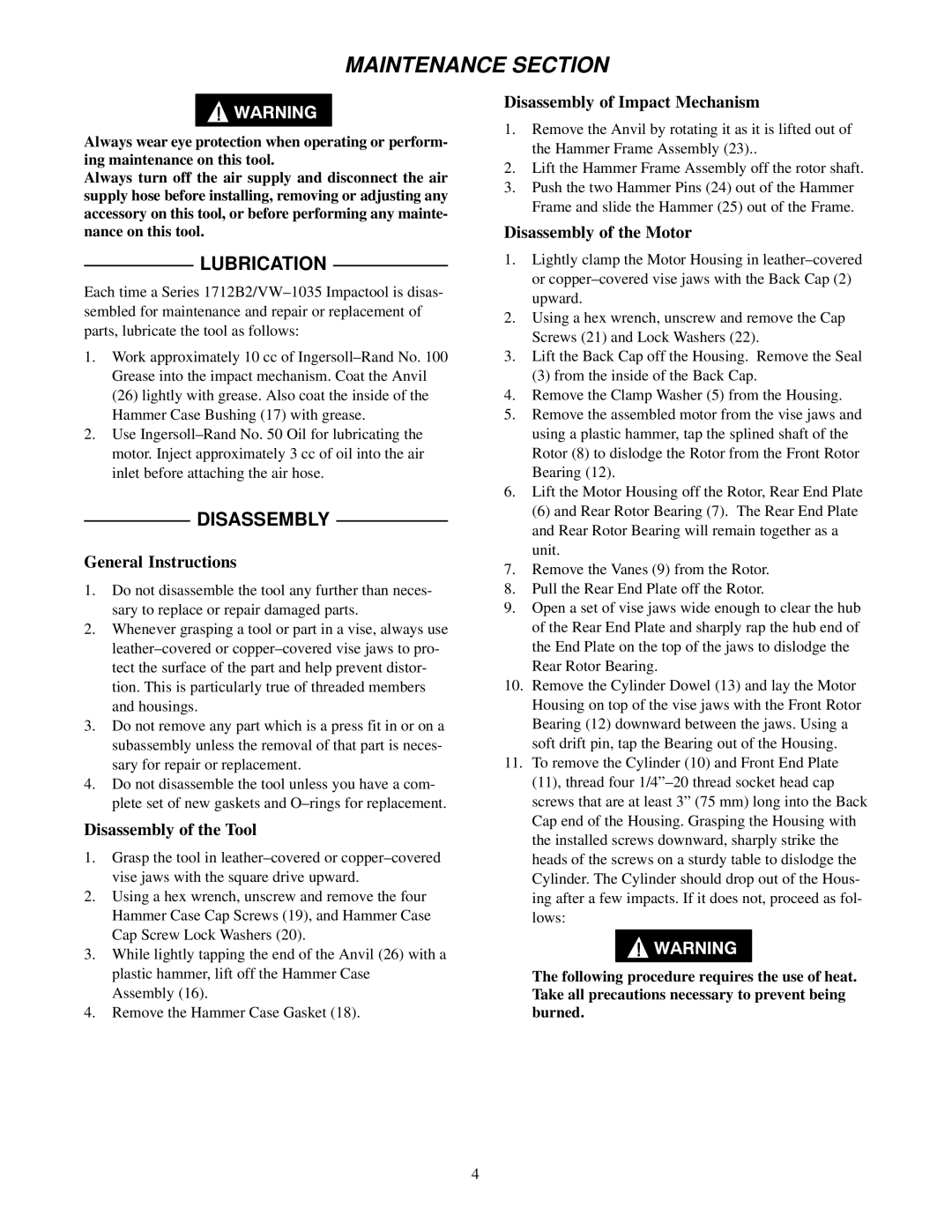
MAINTENANCE SECTION
Always wear eye protection when operating or perform- ing maintenance on this tool.
Always turn off the air supply and disconnect the air supply hose before installing, removing or adjusting any accessory on this tool, or before performing any mainte- nance on this tool.
LUBRICATION
Each time a Series 1712B2/VW±1035 Impactool is disas- sembled for maintenance and repair or replacement of parts, lubricate the tool as follows:
1.Work approximately 10 cc of Ingersoll±Rand No. 100 Grease into the impact mechanism. Coat the Anvil (26) lightly with grease. Also coat the inside of the Hammer Case Bushing (17) with grease.
2.Use Ingersoll±Rand No. 50 Oil for lubricating the motor. Inject approximately 3 cc of oil into the air inlet before attaching the air hose.
DISASSEMBLY
General Instructions
1.Do not disassemble the tool any further than neces- sary to replace or repair damaged parts.
2.Whenever grasping a tool or part in a vise, always use leather±covered or copper±covered vise jaws to pro- tect the surface of the part and help prevent distor- tion. This is particularly true of threaded members and housings.
3.Do not remove any part which is a press fit in or on a subassembly unless the removal of that part is neces- sary for repair or replacement.
4.Do not disassemble the tool unless you have a com- plete set of new gaskets and O±rings for replacement.
Disassembly of the Tool
1.Grasp the tool in leather±covered or copper±covered vise jaws with the square drive upward.
2.Using a hex wrench, unscrew and remove the four Hammer Case Cap Screws (19), and Hammer Case Cap Screw Lock Washers (20).
3.While lightly tapping the end of the Anvil (26) with a plastic hammer, lift off the Hammer Case Assembly (16).
4.Remove the Hammer Case Gasket (18).
Disassembly of Impact Mechanism
1.Remove the Anvil by rotating it as it is lifted out of the Hammer Frame Assembly (23)..
2.Lift the Hammer Frame Assembly off the rotor shaft.
3.Push the two Hammer Pins (24) out of the Hammer Frame and slide the Hammer (25) out of the Frame.
Disassembly of the Motor
1.Lightly clamp the Motor Housing in leather±covered or copper±covered vise jaws with the Back Cap (2) upward.
2.Using a hex wrench, unscrew and remove the Cap Screws (21) and Lock Washers (22).
3.Lift the Back Cap off the Housing. Remove the Seal
(3)from the inside of the Back Cap.
4.Remove the Clamp Washer (5) from the Housing.
5.Remove the assembled motor from the vise jaws and using a plastic hammer, tap the splined shaft of the Rotor (8) to dislodge the Rotor from the Front Rotor Bearing (12).
6.Lift the Motor Housing off the Rotor, Rear End Plate
(6)and Rear Rotor Bearing (7). The Rear End Plate and Rear Rotor Bearing will remain together as a unit.
7.Remove the Vanes (9) from the Rotor.
8.Pull the Rear End Plate off the Rotor.
9.Open a set of vise jaws wide enough to clear the hub of the Rear End Plate and sharply rap the hub end of the End Plate on the top of the jaws to dislodge the Rear Rotor Bearing.
10.Remove the Cylinder Dowel (13) and lay the Motor Housing on top of the vise jaws with the Front Rotor Bearing (12) downward between the jaws. Using a soft drift pin, tap the Bearing out of the Housing.
11.To remove the Cylinder (10) and Front End Plate (11), thread four 1/4º±20 thread socket head cap screws that are at least 3º (75 mm) long into the Back Cap end of the Housing. Grasping the Housing with the installed screws downward, sharply strike the heads of the screws on a sturdy table to dislodge the Cylinder. The Cylinder should drop out of the Hous- ing after a few impacts. If it does not, proceed as fol- lows:
The following procedure requires the use of heat. Take all precautions necessary to prevent being burned.
4
